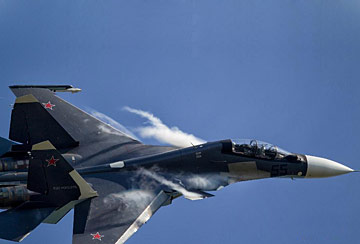 China's new-type guided missile frigate 'Bengbu' in live fire training
China's new-type guided missile frigate 'Bengbu' in live fire training
 China’s weekly story (2013.8.10 - 8.23)
China’s weekly story (2013.8.10 - 8.23)
 Flight team performs first show abroad
Flight team performs first show abroad
 With parents bedridden, 12-year-old boy becomes pillar of the family
With parents bedridden, 12-year-old boy becomes pillar of the family
 Top 10 private Chinese enterprises 2013
Top 10 private Chinese enterprises 2013
 The most gorgeous Chinese women in the eyes of foreigners
The most gorgeous Chinese women in the eyes of foreigners
Therefore the development of a carrier-borne UCAV involves extremely high research costs and a complex development process. If China intends to commission UCAVs similar to the US carrier-borne X-47B, five technical breakthroughs must be made.
The first is advanced aerodynamic design. It can be seen from the shape of the X-47B that these designs improve stealth, increase flight range, and respond to the demands of air attack and combat. The X-47B, the UK "Taranis", and France's "Neuron" all feature a recessed rear inlet and flying-V wings.
The second step is advanced flight control technology. This is the real technical challenge for the UCAV. The carrier-borne UCAV requires a full range of capabilities covering takeoff, cruise, combat, withdrawal, and landing. The demands on the electronic take-off and landing systems for the moving deck of an aircraft carrier are significantly higher than the requirements for a land-based airport.
A UCAV's flight control equipment adjusts the craft in flight. This requires the flight control computer to implement planning and design according to a series of algorithms as quickly as possible after feedback, and update in response to environment changes detected by sensors.


 Mexican president delivers first State of Nation address
Mexican president delivers first State of Nation address Highlights of MAKS 2013 Int'l Aviation and Space Show
Highlights of MAKS 2013 Int'l Aviation and Space Show  10th China-ASEAN Expo opens in Nanning
10th China-ASEAN Expo opens in Nanning Baby born to save his sister - the story of a savior sibling
Baby born to save his sister - the story of a savior sibling Lady of mystery: Female SWAT team in prison disclosed
Lady of mystery: Female SWAT team in prison disclosed  Single mother, baby live in KFC restaurant for months
Single mother, baby live in KFC restaurant for months Top 10 naked hotels in the world
Top 10 naked hotels in the world The most gorgeous Chinese women in the eyes of foreigners
The most gorgeous Chinese women in the eyes of foreigners A collection of bizarre rooftop buildings around China
A collection of bizarre rooftop buildings around China Putin intimate contacts with marine animals
Putin intimate contacts with marine animals China's frigate 'Bengbu'in fire training
China's frigate 'Bengbu'in fire training Fresh students 'forced' to register in university independently
Fresh students 'forced' to register in university independently 2013 Taiwan Int'l Tourism Expo kicks off in Taipei
2013 Taiwan Int'l Tourism Expo kicks off in Taipei Photo story: Take a gap year
Photo story: Take a gap year Nokia's Global Headquarters: visiting a declining empire
Nokia's Global Headquarters: visiting a declining empireDay|Week|Month